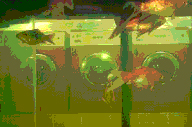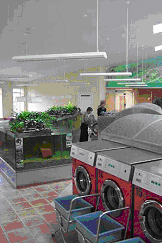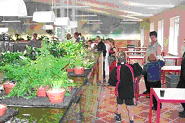 |
 |
 |
 |
 |
 |
 |
 |
 |
 |
 |
 |
Project description
Name of the case study
Folehaven Green Laundry
Description of context
The handling of sewage in Denmark is to a large extent influenced by the Aquatic Environment Action Plans. These plans stem from the late 1980´ies, at that time focus was on the eutrophication of the Baltic and other Danish seas. They meant large investments in sewage treatment plants, basically financed by an increase in the price of water (a sewage tax). The increased water price, a number of campaigns and other measures have lead to a decrease in the water consumption, especially the water consumption in private households. The focus on water and sewage in the early 1990´ies generated a number of experiments with alternative ways of handling wastewater.
The sewage infrastructure in Copenhagen is mainly a one-line system, where rainwater and sewage from households come in the same pipelines. When there is heavy rain, the pipes overflow. The water is lead to retention trenches where it is kept for until the rain is over, and is then lead to the sewage treatment plant. If the capacity of the basins is not big enough, there will be overflow of polluted rainwater and wastewater into the recipients in times of heavy rain. Local collection or percolation of rainwater can help to solve this problem.
Description of project - background
The green laundry is a communal laundry in a non-profit housing department for 1.600 people. The laundry was renovated in 2000, and designed as a "green laundry". The idea is to collect, cleanse and reuse all wastewater from the washing machines for new washes, in order to reduce water consumption and to avoid outlet of sewage. Also, rainwater is being collected and used for washing. The wastewater is cleansed biologically, including an aquarium and a "marshland" with fish and turtles. This serves as an exhibition on the water circuit, especially for children. Furthermore, use of renewable energy has been included in the laundry. Due to this concept, the laundry received massive – and generally positive – attention from the media, from environmental experts and from other non-profit housing associations. In 2002 the green laundry was evaluated, on environmental, social and economic issues.
It is important to notice, that the renovation consists of two parts: A "traditional" renovation of the laundry, where old washing machines, tumble dryers etc. have been changed with new and more efficient equipment – and a "green" (and more spectacular) part, which includes the recirculation of the waste water, storm-water collection and biological treatment of the wastewater.
The main actors in establishing Folehaven Green Laundry were:
• Folehaven social housing department and its local board
• The residents of Folehaven (users of the laundry)
• FB: the Social Housing Association of Folehaven
• 3B: Social Housing Administrators of FB (and Folehaven)
• EBO-consult: Consultants on the biological plant in the laundry
• Lading Arkitekter: evaluators of the laundry
The process started in 1997 when the non-profit housing association FB was planning to renovate the laundry in the Folehaven housing department. Folehaven includes 941 dwellings with app. 1.600 residents. They decided to make the laundry as "green" as possible, by using a concept of cleaning and re-using the water locally in the laundry. The renovated laundry has 24 washing machines, 12 tumble dryers and two large rotary ironers, and it runs app. 50.000 machine-washes per year.
The board of the social housing department in Folehaven heard about the possibilities of making a local biological recirculation through the green guide in 3B. "Green Guides" is a national arrangement of local environmental guides, employed by local organizations (for instance municipalities, housing associations or sports organisations). The guides have to promote a more sustainable way of living, which can be done by informing, inspiring and activating people on a local scale. The green guides were established in 1997, financed by "The Green Fund", a national funding for local environmental initiatives. In 2000 there were app. 100 Green Guides all over Denmark. Although the Green fund in 2001 was abolished by the new right-wing government, some Green Guides have continued.
The board of Folehaven went to the EBO-consultants to have a look a demonstration-plant that had been set up another place in Copenhagen (Kompagnistræde). The idea was presented for the residents, and in spite of some skepticism, it was decided to include a similar plant in the laundry.
The space needed for the water treatment was possible, as a part of the renovation works involved the heating provision in Folehaven being changed from coal fired to district heating, and a former swimming basin was converted for collection of wastewater. The former coal storage (60 m3) is now used for septic tank.



The green laundry
The following elements have been included in the green laundry:
• A biological treatment plant and a storm water collection,
• Heating of the washing water with the district heating’s return water from the apartments of Folehaven,
• Change of energy supply from electricity to gas (for tumble dryers and rotary ironers),
• Ventilation with heat recovery and solar heating,
• Solar cells to produce power for pumps etc.
The biological treatment plant and a storm water collection have been established to avoid use of groundwater. The biological treatment plant cleanses the washing and rinsing water to drinking water quality before it is reused in the machines. As a part of the cleaning process, an 8.5 m3 large aquarium with many fish and plants in it has been established for the users to look at. Other parts of the biological cleaning system also include living organisms (turtles, snails, fish etc.) and different types of plants. These organisms have no functional purpose (e.g. cleaning the water), but aims to illustrate water as an element in nature.
Description of project - objectives/aims
The environmental goals of the laundry were defined as:
• Not use water from the waterworks and to reuse the water from the washing machines,
• To avoid disposal of sewage
• That the water consumption should be reduced from 11.000 m3 to app. 500 m3 per. year, emissions of CO2 reduced to app 125.000 kg per year and use of soap reduced by app. 1/3. The soap can be reduced as the rainwater used for washing is much softer (less concentration of chalk) compared to tap water, and therefore requires less soap. This would result in savings on app. 0,5 mill. DKr per year (app. 70.000 € per year).
• To visualise the possibilities to care for the environment, and to include the residents in the establishment of the green laundry.
Description of project - time interval and stages
The green laundry was completed in 2000, and the evaluation was made in 2002. However, the evaluation caused the owner to improve the laundry, therefore it is both finished and ongoing.
Description of project - financing
The project was financed by support from the Green Fund (a national fund), the Urban Ecological Fund in Copenhagen and Valby Bydel (a local council representing the district (Valby) where Folehaven is located)
Description of project - other sectors involved
The project relates to the energy sector (use of renewable energy and consequences for energy consumption when water management and water equipment is changed locally) and the blue-green sector (recreational and educational use of water).
What tools were used to assess sustainability?
Evaluation of the Folehaven Green Laundry
More information